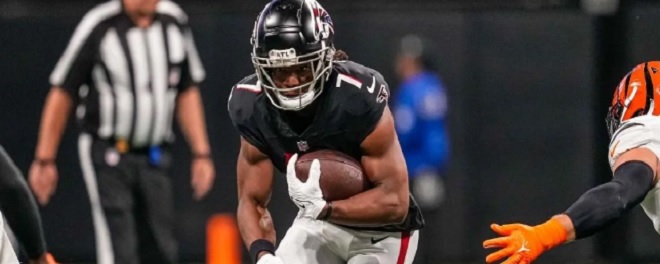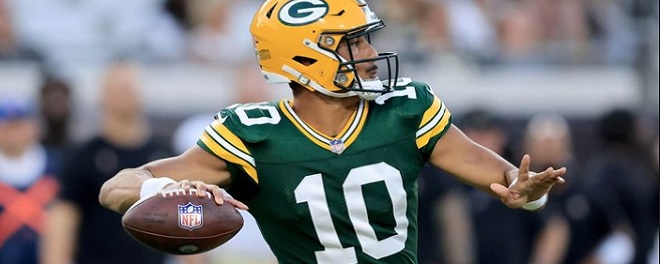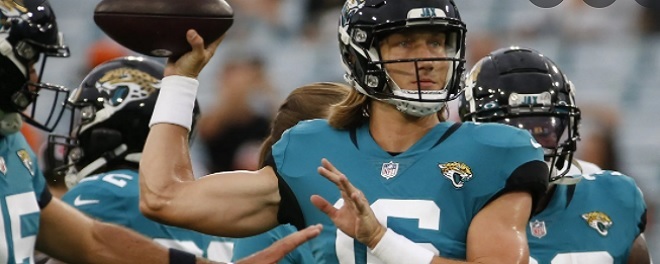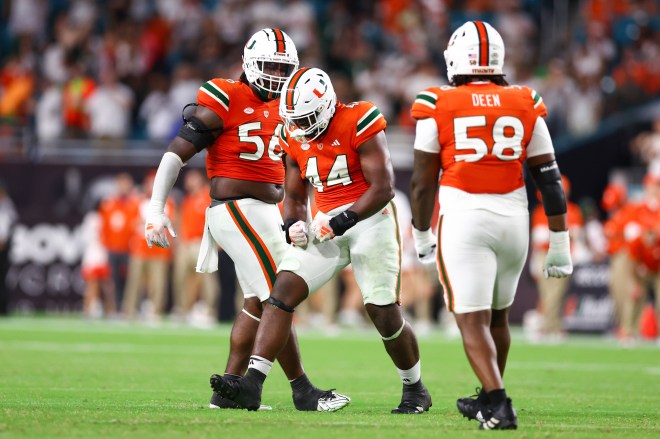By Dan Zaksheske – Dan Z.
Updated Oct. 20, 2021.
Follow @walterfootball for updates.
First off, let me just give a big thank you to WalterFootball.com for giving me a platform to share my thoughts and experience. I’ve been a big fan of this site for a long time, and to be able to actually contribute content is an incredible honor.
Quick background on me: I spent nearly a decade working at ESPN producing audio content, mainly focused on college and NFL football. After leaving ESPN, I joined a sports research company called STAT Factor, where I am the Director of NFL Content and the creator of the “STAT Stack,” where you can find more of my work.
Now, on to the content: Justin Fields made his fourth start of the season this past weekend, a loss to Green Bay that dropped him and the Bears to 2-2 since he took over for Andy Dalton. I watched the tape of the game several times and then did a drive-by-drive analysis of what I saw from the rookie quarterback.
First Drive: Starting at own 20, 11:09 left in 1st quarter, tied 0-0
Bears looking to establish run game early, starting with two runs for a first down. The first pass for Fields is a designed rollout, play-action pass for an easy completion. Fields’ next two throws are sideline routes and throws are on-the-money; he looks more comfortable in the pocket early in this game, but the Packers aren’t generating much pressure. A DPI sets the Bears up at the 1, and they punch it in on the ground to take a 7-0 lead.
Second Drive: Starting on own 15, 4:25 left in the first quarter, Bears lead 7-0
Bears again start on the ground. Khalil Herbert is making noise early, picking up chunks of yards at a time. Nagy showing some confidence in the team by going for a 4th-and-1 from midfield, which they pick up. Unfortunately, it’s a rough drive for Fields. Outside of a short scramble – that set up the fourth-down conversion – and a short wide receiver-screen completion, Fields throws two incompletions, both overthrows to covered receivers. Still seems like he locks onto his first read and that’s where the ball is going no matter what. Then, on a 3rd-and-7, Fields believes he has drawn an offsides – not called – and heaves it downfield; the pass is intercepted. In defense of Fields, he thought he had a free play. However, the heave was nowhere near an intended Bears receiver; the closest, Allen Robinson, was at least 10 yards in front of the safety as the interception was made. Even with a free play, Fields needs to give his receiver a chance to make something happen.
Third Drive: Starting on own 29, 9:52 left in the second quarter, Tied, 7-7
The Packers score on their possession following the pick to tie the game. Fields and the Bears quickly go three-and-out and are forced to punt. Fields throws an incompletion and takes a sack sandwiched around a short Herbert run. Fields had an opportunity to throw the ball away instead of taking the sack and needs to learn to avoid unnecessary hits in these situations.
Fourth Drive: Starting at own 32, 4:01 left in the second quarter, Packers lead 10-7
Fields misses an opportunity on the second play of this drive. Play-action, deep drop for Fields, and he has Allen Robinson running wide-open down the middle of the field but never sees him, despite avoiding the rush to give himself time to survey the field. He tucks and runs instead. Later on the drive, he takes a massive hit on a scramble where he did slide, drawing a personal foul – unfortunately for the Bears, it was offset with by a penalty of their own. On the next play, Fields again just heaves the ball down the field – eerily similar to his earlier interception where Allen Robinson wasn’t even close – and this one should have been picked as well, but the Packer DB failed to keep his feet inbounds at the back of the endzone. The Bears are in field goal range at this point, but Fields tries to call timeout and refs don’t see it, which leads to a delay of game. Next play, he takes a sack. Hard to blame Fields on the sack; the Bears left guard – Cody Whitehair – gets bull-rushed right into Fields’ lap. The Bears, now well outside of field goal range, punt the ball away and we head into the halftime break.
Fifth Drive: Starting at own 25, 15:00 left in the third quarter, Packers lead 10-7
The Bears get the ball to start the second half, still trailing 10-7. Following a first-down run by Herbert for 13 yards, the Bears are unable to pick up another first down and punt. Chicago tries to run a screen that doesn’t work on second down. Third down, as soon as the pocket starts to break down, Fields immediately gives up trying to throw and attempts to scramble, gaining very little.
Sixth Drive: Starting at own 25, 6:00 left in the third quarter, Packers lead 17-7
The Packers score another touchdown on the preceding drive to open up a double-digit lead. Despite an eight-play drive that gains 35 yards, the Bears elect to punt on 4th-and-7 from the Packers’ 40-yard line. Fields makes one strong throw across the middle to Mooney that converted a first down but is otherwise uneventful as the team continues to lean on Herbert. Fields goes 2-5 passing on the drive and is now 9-18 for the game with just 88 yards.
Seventh Drive: Starting at own 20, 15:00 left in the fourth quarter, Packers lead 17-7
Desperately needing points, down two scores in the fourth quarter, the Bears drive 80 yards and get into the endzone. After starting with two runs, Fields makes his best play of the day. With his first read covered and the pocket beginning to collapse, Fields escapes to his left. But, while he’s moving, he keeps his eyes downfield and finds Allen Robinson breaking open in the middle of the field. Fields gets his feet set and makes a very strong throw to pick up 20 yards. On the very next play, Fields hits tight end Cole Kmet for another 20 yards. This one, however, was a first-read throw to a wide-open Cole Kmet and the throw is a little high. Luckily for Kmet, no defender was close enough to lay a hit, but those are the throws that leave receivers vulnerable, especially in the middle of the field. Two plays later, with no one open, Fields reverses field for a 16-yard gain on a scramble, showing off his speed and athleticism. A holding penalty negates a Herbert rushing score and pushes the Bears back to 1st-and-20 from the Green Bay 26, but Fields completes consecutive passes and Herbert runs for a first down on third-and-short. Now first-and-goal from the five, Fields drops back in shotgun and has all day to throw; eventually, Darnell Mooney comes wide open, and Fields hits him for the touchdown.
Seventh-Drive Notes: As someone who has watched every snap of Fields’ young NFL career, I can confidently say this was the best drive he’s ever had. He moved around in the pocket; he made throws beyond his first read; he used his legs when he need to; and, when the team absolutely had to have points, he got them points. He was 5-5 passing on the drive after going 1-7 in his previous seven throws.
Eighth Drive: Starting at own 42, 4:24 left in the fourth quarter, 24-14 Packers lead
Unfortunately for Fields and the Bears offense, the defense couldn’t hold the Packers following the touchdown and they immediately got it back, re-opening the 10-point deficit for Chicago. Early in the drive, Fields makes a nice play to escape a sack and scramble for 16 yards. On the next official play, Fields throws a dart into Mooney to pick up a first down into Green Bay territory on a sideline comeback route. That’s where the good news ends; Fields takes a big sack on the ensuing play. He had some time early, but just didn’t feel the rush in time, though the left guard – Whitehair – gets beaten again. After an RB screen picks up seven yards, Fields gets sacked again on third-and-long. In a spot where the Bears can’t afford it, Fields takes two sacks, both of which could have been avoided by throwing the ball away, but the young QB was trying to hit the home run. The Bears would be forced to go for it on fourth-and-forever, which they did not get, and they would not see the ball again. Packers win, 24-14.
Final thoughts: There are some definite positives to take from this game for the Bears’ young signal-caller, and he showed some improvements from his first start against the Browns. He looked much more comfortable in the pocket, had a few throws to second or third reads, and used his legs more appropriately. Fields has excellent arm talent, there’s no question about it. When he has time to throw and his first read gives him a window, he will hit it. He’s an exceptional athlete whose legs give him an extra edge for off-script plays.
However, too often he continues to lock on to one receiver and force the ball there, even when the coverage is very tight. When the pocket breaks down, he tends to immediately become a runner and not keep his eyes downfield while moving. It seems as if Nagy and the coaching staff are hesitant to give him more than he can handle, and it reminds me a little bit of how Sean McVay would scheme around Jared Goff’s liabilities, though this Bears offense isn’t nearly as creative as those Rams. After four games, I would say it’s clear why Andy Dalton was the starter to open the season: at this point, I believe Andy Dalton is the better NFL quarterback and would give Chicago a better chance to win football games.
Dan Z. is a writer for STAT Factor, a dedicated sports research company that provides many high-profile broadcasters with detailed information on some of the biggest events in sports. To read more of Dan’s work, please subscribe to STAT Stack here.
NFL Power Rankings - Dec. 23
NFL Picks - Dec. 22
2026 NFL Mock Draft - Dec. 17
Fantasy Football Rankings - Sept. 1




